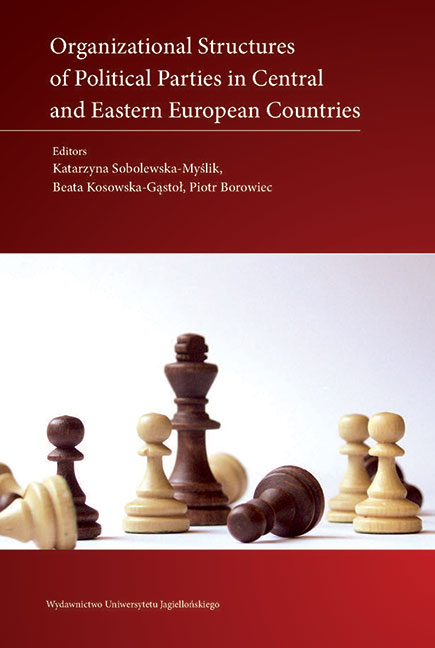Book contents
- Frontmatter
- Contents
- Preface
- Developing Party Structures in Central and Eastern Europe
- Albania: Organizations of Political Parties in Albania
- Belarus: Belarusian Political Parties: Organizational Structures and Practices
- Bosnia and Herzegovina: Organizational Structures of Political Parties in CEE Countries: A Case Study on Bosnia and Herzegovina
- Bulgaria: Organizational Structure and Trends in Bulgarian Party Politics
- Croatia: Organizational Structures of Political Parties in Croatia
- Czech Republic: Between Organizational Extremes: Czech Parties after a Political Earthquake
- Estonia: Organizational Structures of Political Parties in Estonia
- Hungary: Cut from the Same Cloth? A Comparative Analysis of Party Organizations in Hungary
- Kosovo: Structure of the Main Political Parties in Kosovo
- Latvia: Leader-Centered and Power-Hungry: Party Organizations in Latvia
- Lithuania: Organization of Political Parties: The Case of Lithuania
- Moldova: Organizational Structures of Political Parties in The Republic of Moldova
- Montenegro: Party Organization in Montenegro: Structural Resemblance Behind Political Divergence
- Poland: Structures of Polish Political Parties in the Second Decade of the 21st Century
- Romania: The Internal Organization of Romanian Political Parties
- Russia: Parties with Roots Growing Upwards: Organizational Features of Russian Political Parties
- Serbia: Organizational Structures of Political Parties in Serbia
- Slovakia: Organizational Structures of Political Parties in Slovakia: Parties not for Members
- Slovenia: Almost without Any Innovations: Organizational Structures in Slovenian Parties
- Ukraine: Shallow Party Structures in a Volatile Party System
- Comparing Organizational Structures of Political Parties in Central and Eastern European Countries
- Biographical notes about the authors
Belarus: Belarusian Political Parties: Organizational Structures and Practices
- Frontmatter
- Contents
- Preface
- Developing Party Structures in Central and Eastern Europe
- Albania: Organizations of Political Parties in Albania
- Belarus: Belarusian Political Parties: Organizational Structures and Practices
- Bosnia and Herzegovina: Organizational Structures of Political Parties in CEE Countries: A Case Study on Bosnia and Herzegovina
- Bulgaria: Organizational Structure and Trends in Bulgarian Party Politics
- Croatia: Organizational Structures of Political Parties in Croatia
- Czech Republic: Between Organizational Extremes: Czech Parties after a Political Earthquake
- Estonia: Organizational Structures of Political Parties in Estonia
- Hungary: Cut from the Same Cloth? A Comparative Analysis of Party Organizations in Hungary
- Kosovo: Structure of the Main Political Parties in Kosovo
- Latvia: Leader-Centered and Power-Hungry: Party Organizations in Latvia
- Lithuania: Organization of Political Parties: The Case of Lithuania
- Moldova: Organizational Structures of Political Parties in The Republic of Moldova
- Montenegro: Party Organization in Montenegro: Structural Resemblance Behind Political Divergence
- Poland: Structures of Polish Political Parties in the Second Decade of the 21st Century
- Romania: The Internal Organization of Romanian Political Parties
- Russia: Parties with Roots Growing Upwards: Organizational Features of Russian Political Parties
- Serbia: Organizational Structures of Political Parties in Serbia
- Slovakia: Organizational Structures of Political Parties in Slovakia: Parties not for Members
- Slovenia: Almost without Any Innovations: Organizational Structures in Slovenian Parties
- Ukraine: Shallow Party Structures in a Volatile Party System
- Comparing Organizational Structures of Political Parties in Central and Eastern European Countries
- Biographical notes about the authors
Summary
Introduction
In Belarus, a state where elections are an “administrative formality,” political parties are largely irrelevant (Freedom House 2014). They have no representation in the Belarusian parliament, and no say in political processes. Because of its “authoritarian exceptionalism,” Belarus has been excluded from many large-N studies of party and electoral systems (e.g. Birch 2005; Clark and Wittrock 2005).
Even so, there is no dearth of parties in Belarus. Fifteen parties are currently registered with the Belarusian Ministry of Justice, reporting a combined 98,000 members (Kulakevich 2015). The actual number of parties is even higher, as at least four opposition parties have been repeatedly denied registration and thus function illegally.
The authoritarian context accounts for the most salient cleavage in Belarusian politics - namely, attitudes toward the Lukashenka regime. While, on the one hand, the pro-opposition parties are consistently harassed by the state, the pro-regime parties enjoy some degree of patronage. Left-right ideological differences, on the other hand, do not clearly demarcate parties. While the pro-regime parties tend to lean left, following the Belarusian president, the pro-opposition parties span the entire ideological spectrum.
In this chapter we review the characteristics of the Belarusian party system, with a view to explaining how the restrictive political context within which parties operate affects their organizational structure. We examine the legal framework governing party development, and discuss variation in structure across the pro–regime and pro-opposition parties.
We conclude that Belarusian parties do not neatly fall into the ideal categories or types that have been developed in political science literature (Duverger 1954; Gunther and Diamond 2003; Katz and Mair 1995; Neumann 1956; Wolinetz 2002). To comply with national laws, political parties in Belarus have acquired on paper a hierarchical structure corresponding to the administrative division of the state. Most parties also convene caucuses to elect party leadership. This is where their similarity with Duverger's (1954) mass party model ends.
Belarusian parties have remained under-institutionalized since the country gained independence in 1991. In particular the lack of electoral prospects has thinned the base of prospective members; regional offices exist only to fulfill legal requirements; internal party decision-making lacks transparency; and as much as 1/3 of party leaders have led their parties for at least as long as incumbent president Alyaksandr Lukashenka has governed the country (1994 to the present).
- Type
- Chapter
- Information
- Organizational Structures of Political Parties in Central and Eastern European Countries , pp. 41 - 58Publisher: Jagiellonian University PressPrint publication year: 2017



